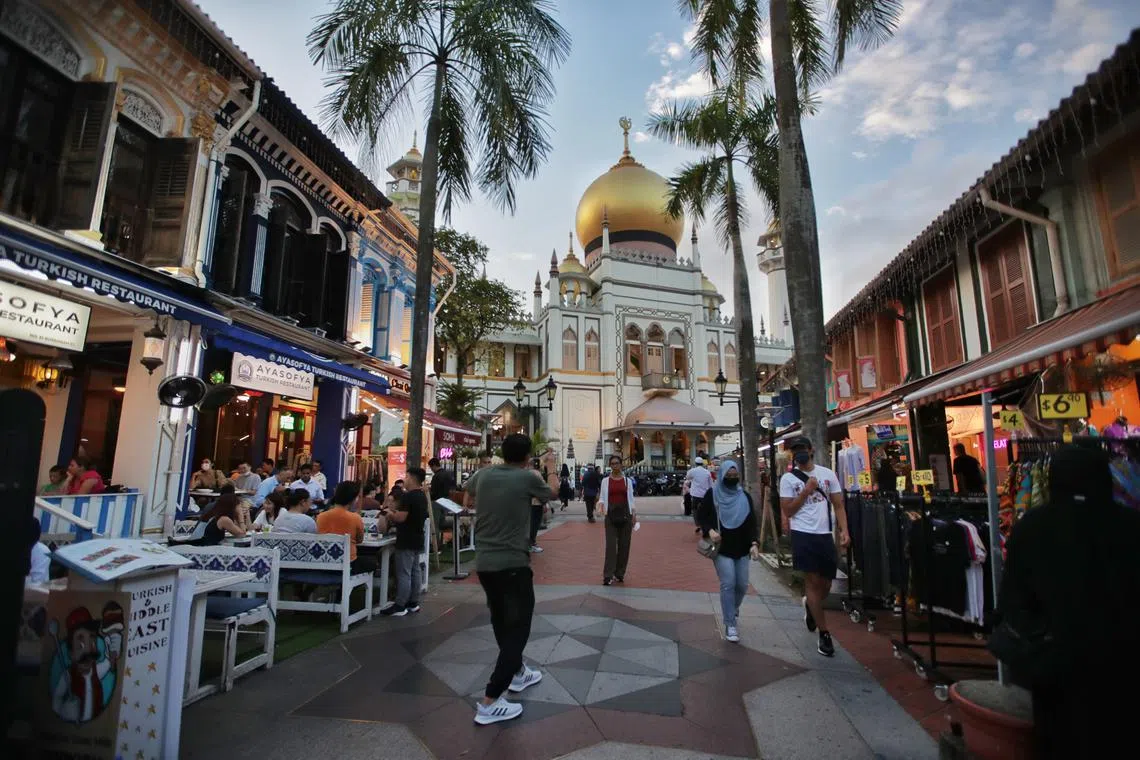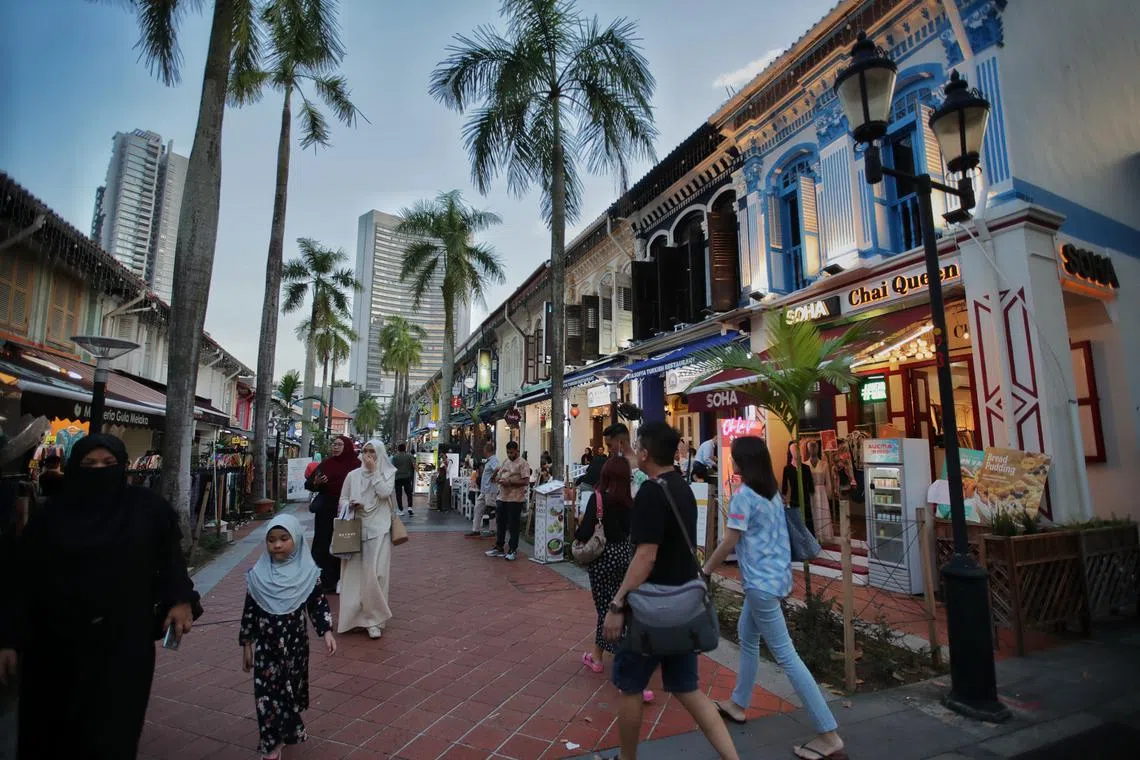Kampong Glam group wants public views on making conservation area a must-visit for S’poreans
Sign up now: Get ST's newsletters delivered to your inbox

The Kampong Gelam Alliance has unveiled a draft place plan that will guide the development of the area over the next five years.
ST PHOTO: GIN TAY
Follow topic:
SINGAPORE – When Covid-19 was at its peak in 2020 in Singapore, Mr Johari Kazura saw an area that he had known all his life to be bustling and busy come to a standstill.
“I was walking down the neighbourhood on a Tuesday afternoon and everything was shut. It was quiet, it was kind of scary,” said the 47-year-old, whose family has been selling perfume in Kampong Glam for about nine decades.
Some businesses closed down during the pandemic, while others, such as eateries popular among locals, managed to weather the storm and bring life back to the conservation area, despite the lack of tourist footfall, he noted.
“This told us who the more resilient businesses in the area are. After going through the hardship, they managed to get through to the other side,” said Mr Kazura, a member of the Kampong Gelam Alliance (KGA) – a voluntary group comprising residents, cultural institutions, business organisations, property owners and hotels in the historical area.
On Saturday, KGA unveiled a plan that will guide the rejuvenation of Kampong Glam over the next five years, as the area’s stakeholders work to make the precinct more relevant to Singaporeans of all ages.
The plan is “pretty much a business plan, but with more heart”, said Mr Kazura. “It is something not just about business, but also takes into account the needs and wants of the community, as well as the people who wish to visit the area,” he said.
The plan has a four-pronged approach.
It aims to have a mix of new and traditional trades, create public spaces, improve connectivity, as well as celebrate the area’s history, heritage, culture and arts.
KGA said the plan was born out of the Emerging Stronger Conversations organised by the Government to discuss how various sectors could address challenges brought about by the pandemic.
At the end of 2020, the Urban Redevelopment Authority (URA) – Singapore’s conservation agency – facilitated a discussion among KGA members, as well as Kampong Glam residents, cultural institutions and heritage businesses, on how to harness the area’s heritage to serve Singaporeans better.
KGA, whose 16 members include residents, as well as institutions and organisations such as Sultan Mosque and the Singapore Malay Chamber of Commerce and Industry, then developed the plan, which is available for viewing at www.listeningtoKG.org
From Saturday till Jan 15, 2023, members of the public can share their views on the plan, and any changes they wish to see in Kampong Glam, on the same website.
KGA will also be organising “walkshops” for the public to provide in-depth feedback on the plan, which will involve walking to various spots in Kampong Glam that the alliance wants to gather views on. More details on these walks will be posted on KGA’s Facebook page.
KGA chairman Saeid Labbafi said Kampong Glam has more than 600 shophouses owned by different owners, and, unlike shopping malls, does not have a central management to curate its mix of tenants.

Kampong Glam has more than 600 shophouses owned by different owners.
ST PHOTO: GIN TAY
While individual landlords get to decide who to lease their property to, KGA aims to work with stakeholders and government agencies to ensure the area remains vibrant, while also supporting heritage businesses, he added.
“Kampong Glam is a commercial place, but it also has a lot of values that we want to promote,” said Mr Saeid.
KGA had identified the area’s association with the Malay-Muslim community and the Islamic faith as one of its strengths, but also noted that Kampong Glam attracts Singaporeans of all races.
Former Nominated MP Faizah Jamal, a third-generation resident of Kampong Glam and a KGA member, said the plan is about having the historical area’s stakeholders, including landlords and tenants, understand and embody its roots, as well as the spirit of the close-knit multicultural resident community that it had in the 1900s.
“To me, it’s about how we harness the values of the community that people like me grew up in – where everybody is looking out for everybody,” said Ms Faizah, who is among about 100 residents currently living in the conservation area.
She said that some businesses in the area have come and gone in the past few years for various reasons, including rising rentals, making it difficult to build a strong community. She added: “Gentrification is so fast-paced, it’s worrying.”
As it works towards finalising the plan by the first quarter of 2023, KGA will be tapping insights from the National Heritage Board’s Kampong Gelam Citizen Engagement Project.
The board had trained 47 volunteers for the project, to document the history of heritage businesses within the precinct and how they have contributed to its cultural identity.
In total, 45 businesses were documented, and their stories can be found at go.gov.sg/kampong-gelam-citizen-engagement-project
On Saturday evening, Minister of State for National Development and adviser to KGA, Associate Professor Muhammad Faishal Ibrahim, visited Kampong Glam, including some of the area’s heritage businesses.
Asked if the Government would encourage stakeholders of other conservation areas to develop similar plans, Prof Faishal said the URA is open to working with other districts, and noted that the Kampong Glam plan heavily involved the area’s stakeholders.


